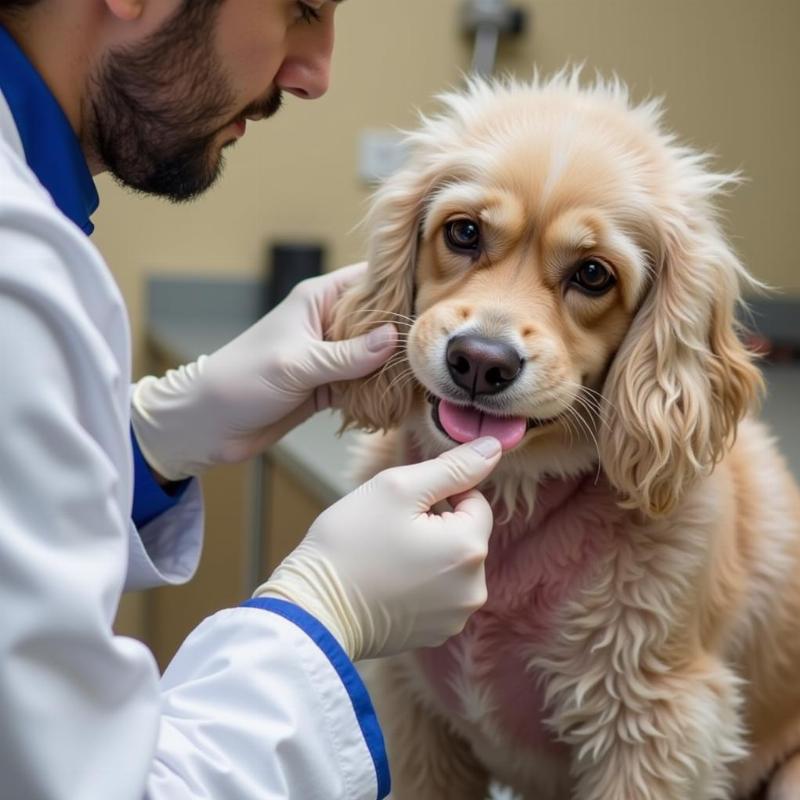Apple cider vinegar (ACV) is a popular home remedy for various dog ailments, including mange. But does this pantry staple really hold up against this persistent skin parasite? This article will delve into the science behind using apple cider vinegar for mange in dogs, exploring its potential benefits, risks, and offering practical guidance for concerned pet owners in the United States. We’ll separate fact from fiction and equip you with the knowledge to make informed decisions about your dog’s health.
Mange is a frustrating and often painful skin condition caused by mites. It can lead to intense itching, hair loss, and skin infections. While several effective veterinary treatments exist, many pet owners are drawn to natural remedies like apple cider vinegar, hoping for a gentler, less expensive solution. So, let’s examine the evidence.
Understanding Mange in Dogs
Before we discuss ACV, it’s crucial to understand what mange is. There are two main types: demodectic mange, caused by the Demodex mite, and sarcoptic mange (also known as scabies), caused by the Sarcoptes scabiei mite. Demodectic mange is often manageable with topical treatments, while sarcoptic mange, which is highly contagious, requires more aggressive veterinary intervention. Knowing the type of mange your dog has is essential for effective treatment.
Can Apple Cider Vinegar Help with Mange?
The purported benefits of apple cider vinegar for mange stem from its acetic acid content, which is believed to alter the skin’s pH, making it less hospitable to mites. Anecdotally, some pet owners report seeing improvements in their dog’s skin condition after applying diluted ACV. However, scientific evidence supporting these claims is limited. While ACV may offer some relief from itching due to its anti-inflammatory properties, it’s unlikely to eradicate the mites completely.
How to Use Apple Cider Vinegar for Mange in Dogs (If You Choose To)
If you decide to try apple cider vinegar for your dog’s mange, always consult your veterinarian first. They can diagnose the type of mange and advise on the best course of action. If they give you the go-ahead, you can create a diluted ACV solution by mixing one part ACV with one part water. Apply this solution to the affected areas with a cotton ball, avoiding open sores or irritated skin. Monitor your dog for any adverse reactions, such as excessive licking or redness.
Veterinary Treatments for Mange
While ACV might offer temporary relief, it’s essential to remember that veterinary-prescribed treatments are the most effective way to eliminate mange. These treatments may include medicated shampoos, dips, oral medications, or injections. Your veterinarian will tailor the treatment plan to your dog’s specific needs and the type of mange they have.
 Dog with Mange Receiving Treatment
Dog with Mange Receiving Treatment
Preventing Mange in Dogs
Prevention is always better than cure. Regularly grooming your dog, keeping their environment clean, and minimizing contact with potentially infected animals can significantly reduce the risk of mange.
When to See a Vet
If you suspect your dog has mange, don’t delay seeking veterinary care. Early diagnosis and treatment are crucial for preventing the condition from worsening and spreading. Look out for symptoms such as intense itching, hair loss, redness, and crusting of the skin.
Conclusion
While apple cider vinegar for mange in dogs might offer some anecdotal benefits for soothing itchy skin, it’s not a substitute for professional veterinary care. Always consult your veterinarian for accurate diagnosis and treatment. They can guide you on the most effective approach to managing your dog’s mange and ensuring a full recovery.
FAQ
- Is apple cider vinegar safe for dogs? Diluted apple cider vinegar is generally safe for topical application on dogs, but always consult your vet before using it, especially on broken skin.
- What are the symptoms of mange in dogs? Common symptoms include intense itching, hair loss, redness, and crusting of the skin.
- How is mange diagnosed in dogs? Veterinarians typically diagnose mange through a physical examination and skin scraping.
- Can mange spread to humans? Sarcoptic mange can be transmitted to humans, causing temporary itching.
- How can I prevent mange in my dog? Regular grooming, a clean environment, and limited contact with potentially infected animals can help prevent mange.
- How long does it take to treat mange in dogs? Treatment duration varies depending on the type of mange and the severity of the infestation.
- Can I use apple cider vinegar along with prescribed medications? Always consult your veterinarian before combining any home remedies with prescribed medications.
Beautdogs.us is your premier online resource for all things dog-related in the USA. We offer expert advice on dog breeds, grooming, health, and much more. From puppyhood to senior years, Beautdogs.us is here to help you navigate the joys and challenges of dog ownership. Contact us today at [email protected] or +1 501-555-7529 for personalized guidance. Beautdogs.us – Your trusted companion in canine care.